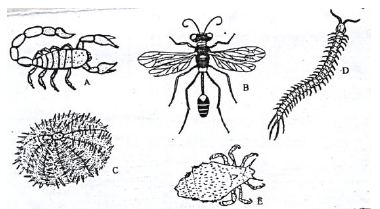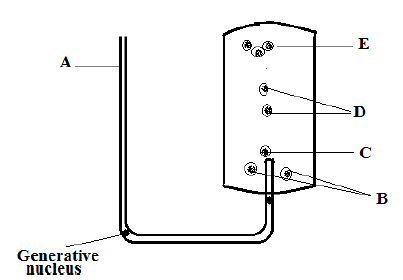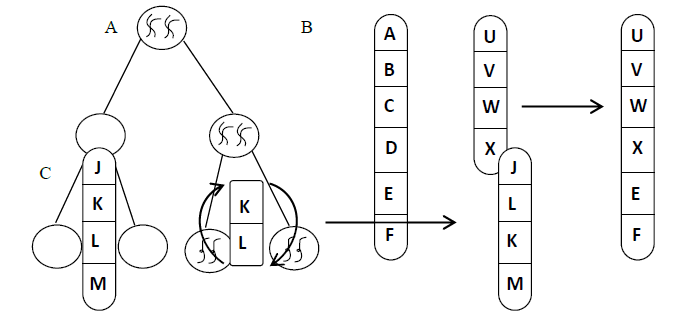- A person walked bare feet in a swampy area. After a few weeks he started experiencing abdominal pains and diarrhoea. His urine and stool contained...(Solved)
A person walked bare feet in a swampy area. After a few weeks he started experiencing abdominal pains and diarrhoea. His urine and stool contained blood.
(a) Name the disease the person was likely to be suffering from and the causative agent of the disease
(i) Disease
(ii) Causative agent
(b.) Apart from avoiding walking bare feet in swampy area. State two other ways of controlling the disease.
Date posted: September 13, 2019. Answers (1)
- Explain the meaning of homoiothermic.(Solved)
Explain the meaning of homoiothermic.
Date posted: September 13, 2019. Answers (1)
- You are provided with photographs of animals. Study the photographs and the dichotomous key below to enable you identify the taxonomic group to which each...(Solved)
You are provided with photographs of animals. Study the photographs and the dichotomous key below to enable you identify the taxonomic group to which each animal belongs.

KEY
1. a) Jointed legs present ………………………………………………………………go to 2
b) Jointed legs absent………………………………………………………………..go to 7
2. a) Three pairs of legs ………………………………………………………………..go to 3
b) More than 3 pairs of legs………………………………………………………….go to 5
3. a) Wings present …………………………………………………………………….go to 4
b) Wings absent………………………………………………………………………Anoplura
4. a) One pair of wings…………………………………………………………………Diptera
b) Two pairs of wings……………………………………………………………Hymenoptera
5. a) Four pairs of legs ………………………………………………………………… Arachnida
b) More than ten pairs of legs ………………………………………………………. go to 6
6. a) One pair of legs in each body segment…………………………………………… Chilopoda
b) Two pairs of legs in each body segment ………………………………………… Diplopoda
7. a) Body partially enclosed in a shell………………………………………………… Mollusca
b) Body surface has spiny projection…………………………………………….Echinodermata
a) Using the key, identify the following organisms to their taxonomic groups. In each case, give the sequence of steps which you followed in identifying them.

b) i) Using observable features only, state the class to which the animal labeled A and B on the photographs above belong.State two observable features on B, that enabled you to arrive at that answer in (b) (i) above.
Date posted: September 13, 2019. Answers (1)
- Study the reaction below and answer the questions that follow.(Solved)
Study the reaction below and answer the questions that follow.

a) What biological processes are represented by A and B?
b) Identify the product Y.
c) State the bond represented by X.
Date posted: September 13, 2019. Answers (1)
- A student divided a small air tight box into two chambers with wire mesh. In one chamber he kept a number of rats and in...(Solved)
A student divided a small air tight box into two chambers with wire mesh. In one chamber he kept a number of rats and in the other a number of potted plants. What was likely to happen if the box was placed in the dark for two hours? Explain your answer.
Date posted: September 13, 2019. Answers (1)
- Describe what happens in the first phase of aerobic respiration.(Solved)
Describe what happens in the first phase of aerobic respiration.
Date posted: September 13, 2019. Answers (1)
- State one example of chromosomal mutation that lead to
(i) Change in chromosomal structure
(ii) Change in chromosomal number(Solved)
State one example of chromosomal mutation that lead to
(i) Change in chromosomal structure
(ii) Change in chromosomal number
Date posted: September 13, 2019. Answers (1)
- The following are short messages (sms) on cell phone communication between Mrs. Mkenzie and her husband. They can be used as analogies of gene mutation.(Solved)
The following are short messages (sms) on cell phone communication between Mrs. Mkenzie and her husband. They can be used as analogies of gene mutation.

For each of these messages identify the type of gene mutation illustrated
Date posted: September 13, 2019. Answers (1)
- When transplanting a seedling, it is advisable to remove some of the leaves. Explain(Solved)
When transplanting a seedling, it is advisable to remove some of the leaves .Explain
Date posted: September 13, 2019. Answers (1)
- The figure below shows the embryo-sac before fertilization.(Solved)
The figure below shows the embryo-sac before fertilization.

(a) Identify the structures labeled A and B.
(b) Identify the structures labelled in the diagram that will develop into the following after fertilization.
(i) Embryo
(ii) Endosperm
(c) State the ploidy of each the following nucleic after fertilization
(i) C
(ii) D
Date posted: September 13, 2019. Answers (1)
- In maize the gene for the purple colour is dorminant for the gene for white colour. A purple colour was crossed with heterozygous plant. Using...(Solved)
In maize the gene for the purple colour is dorminant for the gene for white colour. A purple colour was crossed with heterozygous plant. Using letter G to represent the gene for purple colour, work out the genotypic ratio of the offspring. Show your working.
Date posted: September 13, 2019. Answers (1)
- State two factors that denature enzymes.(Solved)
State two factors that denature enzymes.
Date posted: September 13, 2019. Answers (1)
- Why does a membrane form around the egg after fertilization?(Solved)
Why does a membrane form around the egg after fertilization?
Date posted: September 13, 2019. Answers (1)
- A student was using a microscope whose eyepiece lens was marked X4. The high powered objective lenses were marked X10. Calculate the total magnification of...(Solved)
A student was using a microscope whose eyepiece lens was marked X4. The high powered objective lenses were marked X10. Calculate the total magnification of the microscope
Date posted: September 13, 2019. Answers (1)
- Distinguish between Attenuation and Vaccination?(Solved)
Distinguish between Attenuation and Vaccination?
Date posted: September 13, 2019. Answers (1)
- The diagrams below illustrate some chromosome mutations.(Solved)
The diagrams below illustrate some chromosome mutations.

(a) Identify the mutations illustrated above.
(b) Give an example of a disorder in humans caused by mutation A above.
Date posted: September 13, 2019. Answers (1)
- Give an example of a beneficial mutation in plants.(Solved)
Give an example of a beneficial mutation in plants.
Date posted: September 13, 2019. Answers (1)
- (a) In which organ is cardiac muscle found.
(b) What is the function of the cardiac muscle in the organ you have named in (a)...(Solved)
(a) In which organ is cardiac muscle found.
(b) What is the function of the cardiac muscle in the organ you have named in (a) above.
Date posted: September 13, 2019. Answers (1)
- (a) Given a sample of urine, name one test you would carry out to determine if it was obtained from a person suffering from diabetes...(Solved)
(a) Given a sample of urine, name one test you would carry out to determine if it was obtained from a person suffering from diabetes mellitus.
(b) What results are expected if one is diabetic?
Date posted: September 13, 2019. Answers (1)
- A goat weighing 20kg requires 216KJ while a mouse weighing 54gms requires 2830KJ per day. Explain.(Solved)
A goat weighing 20kg requires 216KJ while a mouse weighing 54gms requires 2830KJ per day. Explain.
Date posted: September 13, 2019. Answers (1)